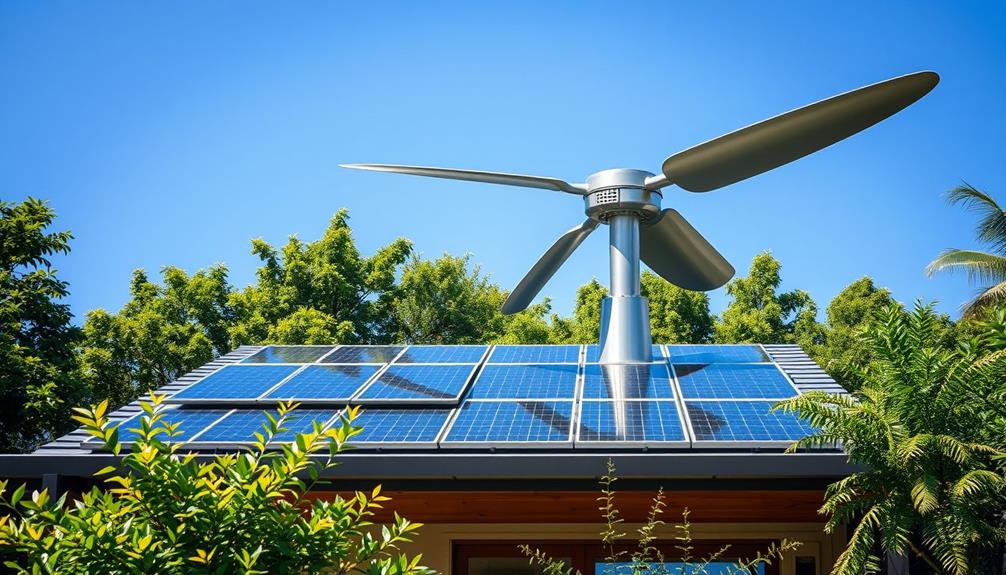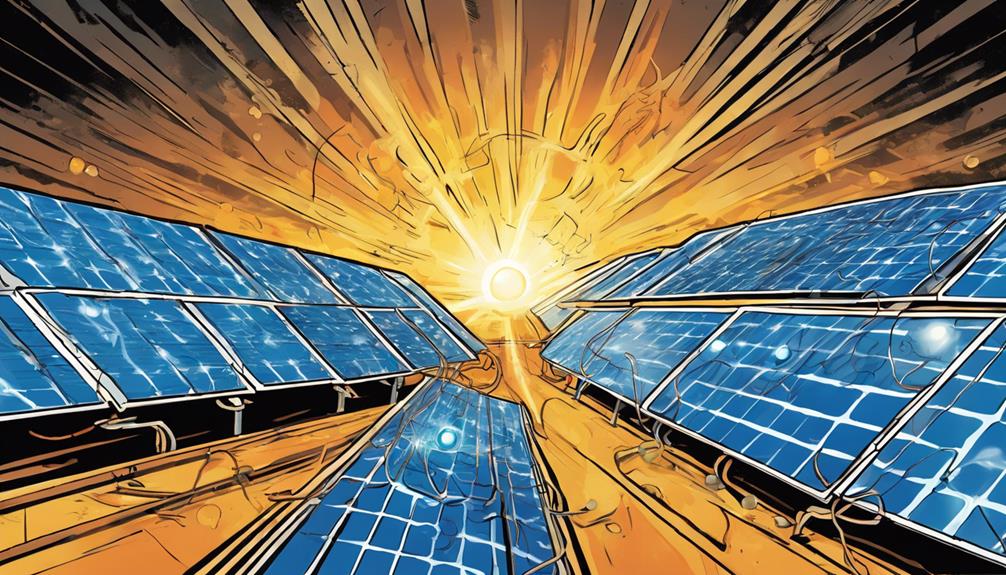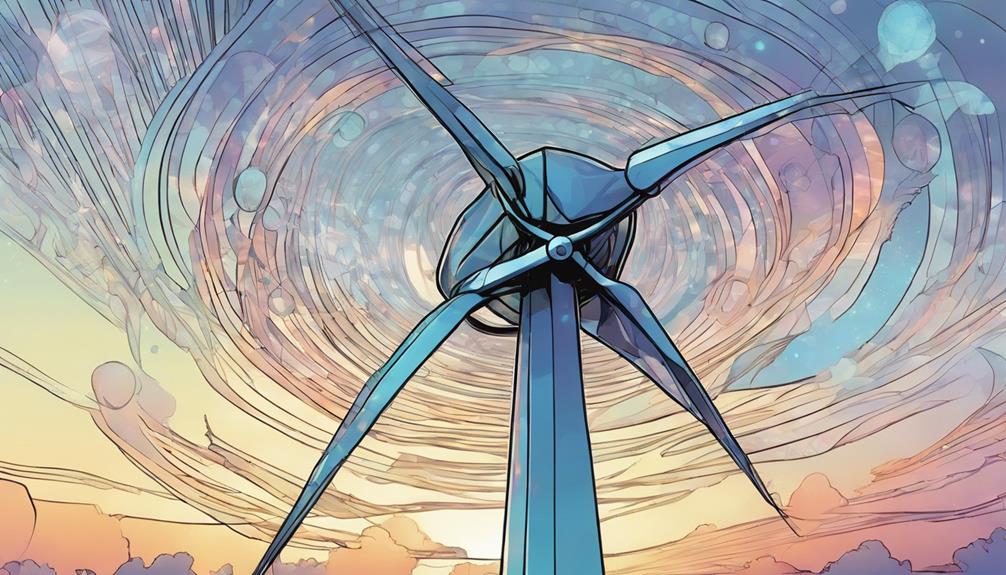A solar roof fan is your ticket to a cooler home and lower energy bills! By harnessing sunlight, these fans enhance attic ventilation, reducing the strain on your air conditioning by up to 30%. They operate on free solar energy, cutting ongoing costs to zero. Plus, you'll enjoy potential monthly savings of $60-$70, making them a smart investment that can also qualify you for a 30% federal tax credit. With minimal maintenance and a long lifespan, solar roof fans contribute to a healthier living environment. Stick around to discover how you can choose the right fan for your home!
Key Takeaways
- Solar roof fans use solar energy to enhance attic ventilation, reducing indoor temperatures and cooling costs during summer months.
- They can lower air conditioning workload by up to 30%, resulting in potential monthly savings of $60-$70.
- A 30% federal tax credit is available for installations from 2022 to 2032, significantly reducing upfront costs.
- Solar fans improve indoor air quality by reducing humidity and preventing mold growth, contributing to a healthier living environment.
- With minimal maintenance and a lifespan exceeding 15 years, solar fans provide long-term energy efficiency and cost savings.
Overview of Solar Roof Fans
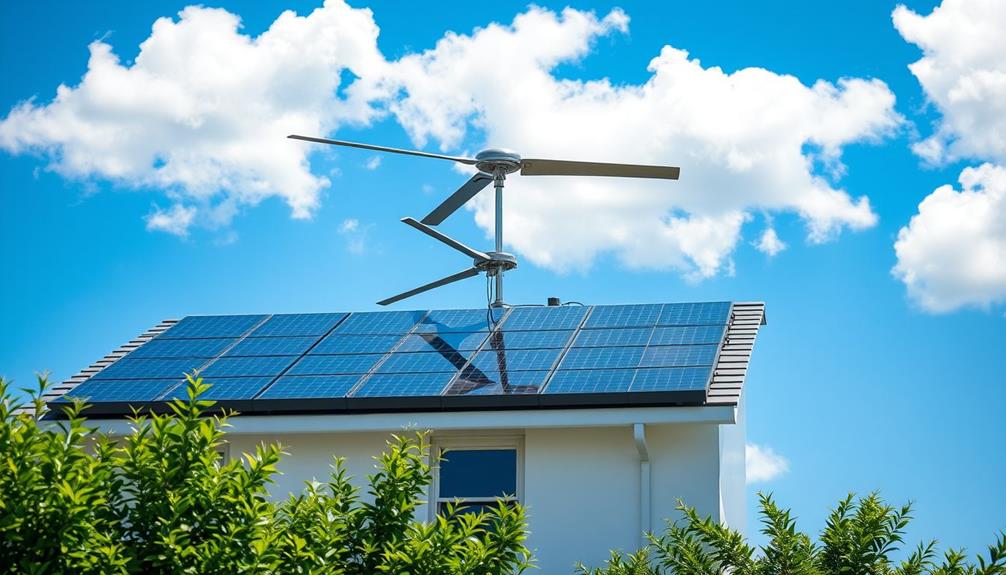
Solar roof fans bring a revitalizing change to energy efficiency in your home. These solar attic fans harness the power of sunlight through photovoltaic cells, converting it into electricity to cool your attic effectively.
Operating continuously during daylight hours, they draw hot air out of your attic, promoting better ventilation and relieving your air conditioning system from excessive strain. This improved ventilation can also help extend the life of your HVAC system by preventing overheating—a common issue caused by inadequately ventilated attics.
Additionally, optimal comfort in varying weather conditions enhances living quality, making solar roof fans a smart investment.
By investing in these energy-efficient attic ventilation fans, you can save money on your energy bills, especially during those hot summer months. Many homeowners report savings of $60 to $70 per month, making the average cost of around $200 for installation a smart financial choice.
Plus, the installation process is straightforward, requiring just basic tools—perfect for DIY enthusiasts who want to tackle the project themselves.
Don't forget, solar attic fans also qualify for significant federal tax credits, currently at 30% for installations completed from 2022 to 2032. This added financial incentive makes solar roof fans a compelling option for those looking to enhance their home's energy efficiency while keeping it cool and comfortable.
Benefits of Solar Attic Fans
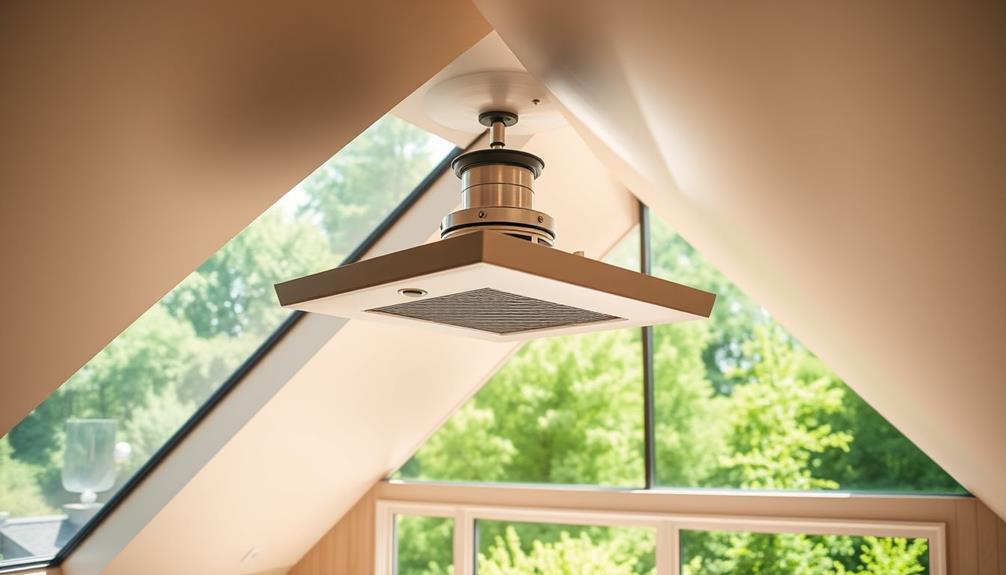
When you install a solar attic fan, you can save a significant amount on your energy bills while keeping your home cooler during those hot summer months. Additionally, using solar fans for home can help reduce your carbon footprint by utilizing clean, renewable energy. These fans are also low maintenance and can provide added ventilation for your attic, helping to prolong the life of your roof and prevent issues such as moisture buildup. Overall, investing in solar fans for home can provide both cost savings and environmental benefits.
Additionally, a solar attic fan can efficiently reduce the buildup of heat in your attic, much like how a wood pellet fireplace maintains consistent warmth in your living spaces.
Plus, it helps improve indoor air quality by reducing humidity and preventing mold growth.
This means not only a more comfortable living space but also a healthier environment for you and your family.
Energy Savings Potential
Harnessing the power of the sun, solar attic fans can greatly reduce your cooling costs. By implementing a solar attic fan, you could save between $60 to $70 each month during the summer, slashing your reliance on air conditioning systems.
These solar fans operate on free solar energy, so you won't have to worry about ongoing operational costs like you'd with electric fans. Additionally, as energy distribution technology evolves, the integration of renewable sources like solar power enhances reliability and sustainability in energy consumption renewable energy goals.
The average installation cost for a solar attic fan system is around $200, but thanks to the federal tax credits, you can offset that expense considerably. For installations made from 2022 to 2032, you'll benefit from a 30% tax credit, enhancing your energy savings even further.
Not only do solar attic fans help you save money now, but they also improve your home's value with energy-efficient upgrades. By preventing heat buildup and moisture accumulation, these fans extend the lifespan of your roofing materials, leading to reduced replacement costs in the long run.
With solar attic fans, you're making a smart investment that pays off in both immediate savings and future benefits.
Indoor Air Quality Improvement
Improving indoor air quality is one of the important benefits of installing a solar attic fan, as it actively reduces moisture buildup that can lead to mold and mildew growth. By promoting better ventilation, these fans effectively expel stale air while drawing in fresh air, which helps lower the concentration of harmful toxins like dust and allergens in your home.
Regular maintenance of air purifiers, such as cleaning filters, can further enhance the overall air quality in conjunction with solar attic fans, ensuring a thorough approach to indoor air management air purifier maintenance dos.
When you maintain even attic temperatures, solar attic fans prevent condensation, which not only averts mold growth but also combats respiratory issues for you and your family. The improved air circulation they provide greatly reduces airborne contaminants, ensuring a fresher and more comfortable indoor atmosphere.
Moreover, using a solar attic fan is an eco-friendly choice. Since it operates on renewable energy, it contributes to lower carbon emissions, enhancing overall air quality both indoors and outdoors.
How Solar Attic Fans Work
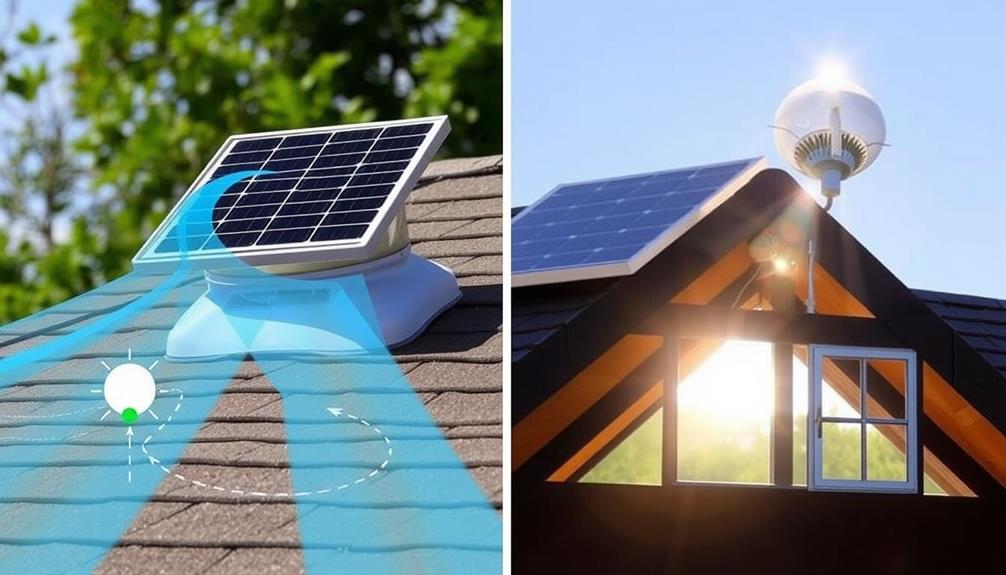
Solar attic fans harness the power of photovoltaic cells to convert sunlight into electricity, driving the fan motor that expels hot air from your attic.
These energy-efficient solutions are similar to innovative designs like unique and wicked planters that enhance home aesthetics while being environmentally friendly.
With a built-in thermostat, these fans kick in automatically when temperatures rise, ensuring your attic stays cool and well-ventilated.
Photovoltaic Cell Functionality
At the heart of solar attic fans is the innovative use of photovoltaic (PV) cells, which convert sunlight directly into electricity. These cells harness solar energy to power the fan, effectively expelling hot air from your attic. This process not only helps maintain a lower attic temperature but also enhances your home's cooling performance.
Additionally, installing a solar attic fan can serve as a valuable part of a diversified energy-saving strategy, similar to how investors explore options like IRA rollovers to gold for protection against market fluctuations.
When the attic temperature rises, the solar attic fan kicks into action, actively drawing out hot air and allowing cooler air to circulate. This efficient operation greatly reduces the workload on your air conditioning system, leading to notable energy savings.
In fact, you could save between $60 and $70 per month during the summer months simply by relying less on conventional cooling methods.
One of the best aspects of solar attic fans is that they operate maintenance-free and can still function on cloudy days, maximizing their efficiency regardless of weather conditions.
With the average cost of a solar fan system around $200, the investment pays off quickly through reduced energy bills.
Thermostat-Controlled Operation
Utilizing a built-in thermostat, solar attic fans automatically spring into action when your attic reaches a specific temperature threshold. This smart feature guarantees that the fans kick on during the hottest parts of the day, effectively expelling hot air and maintaining a cooler environment.
As the fans operate using photovoltaic (PV) cells powered by sunlight, you won't incur any additional energy costs, unlike traditional electric fans that may only run intermittently based on their thermostat settings. By integrating energy-efficient solutions like these, homeowners can enhance their self-reliance and promote a sustainable approach to energy use.
By efficiently managing attic temperatures, solar attic fans help regulate indoor climates and improve air quality, preventing issues like mold growth caused by heat buildup and moisture accumulation.
You're not just gaining comfort; you're also looking at significant energy savings. With consistent operation during daylight hours, these fans can reduce the workload on your air conditioning system by up to 30%, leading to lower cooling costs.
Incorporating a solar attic fan into your home's ventilation system is a smart, eco-friendly choice that not only enhances your comfort but also contributes to a more sustainable lifestyle.
Comparing Solar and Electric Fans
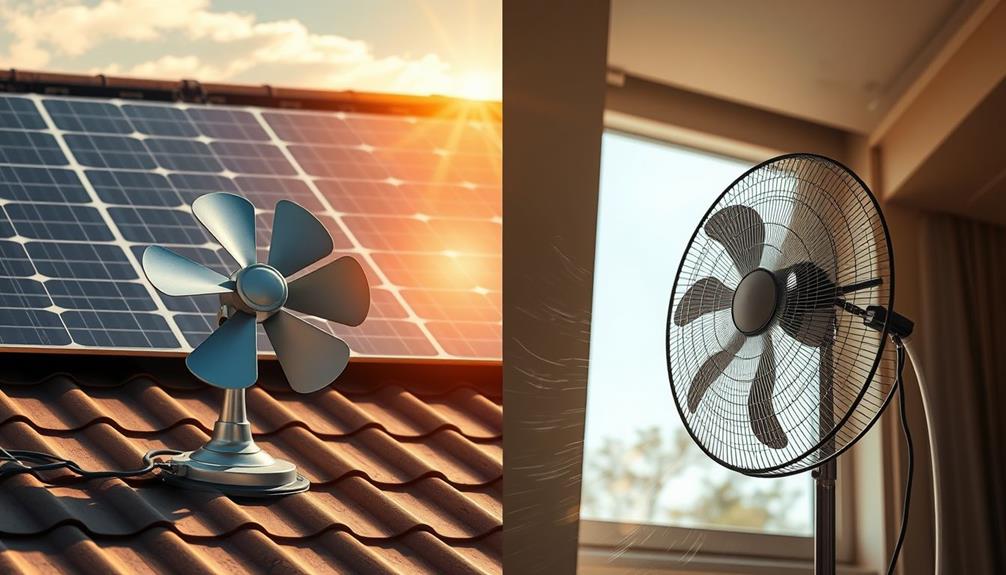
When it comes to cooling solutions for your home, solar attic fans offer a compelling alternative to traditional electric fans. Operating on free solar energy, these fans incur zero operating costs, while electric fans can lead to significant ongoing electricity expenses. You won't have to worry about the electricity bill piling up when you choose solar fans.
Additionally, just as aquatic exercise provides invigorating benefits in a different environment, solar attic fans promote energy efficiency in your home. Unlike electric fans that might cut off based on thermostat settings, solar attic fans provide consistent cooling throughout the day, running whenever the sun shines. This continuous operation can lead to energy savings of up to 30% on your air conditioning costs, as solar fans help reduce the workload on your HVAC system.
When it comes to installation, solar attic fans are straightforward to set up, requiring no electrical work or modifications, making them perfect for DIY enthusiasts. In contrast, electric fans often involve higher upfront costs and complex installation processes.
Additionally, solar fans boast a longer lifespan, often exceeding 15 years with minimal maintenance, compared to electric fans that may need frequent replacements. Ultimately, choosing solar attic fans can enhance your home's comfort while keeping costs down.
Installation Process for Solar Fans
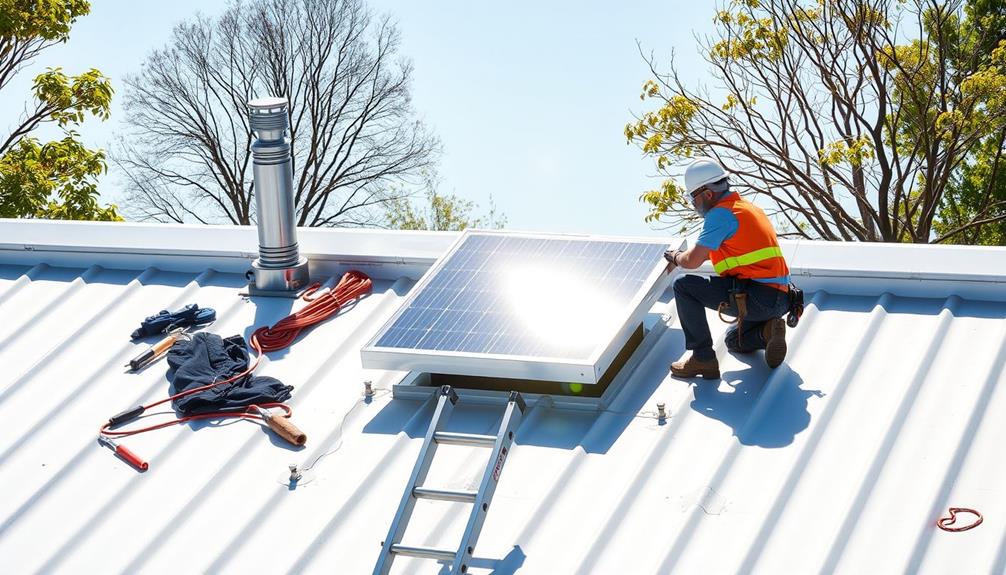
When you're ready to install your solar fan, you'll need some basic tools like a jig saw and drill.
It's also beneficial to confirm that your roof is in good condition before installation, as any existing damage could affect the fan's performance.
Follow the step-by-step instructions included with your fan, and don't forget to prioritize safety while cutting through your roof.
Proper planning and execution will guarantee a smooth installation process and peak performance, especially if you consider well-draining soil essential for preventing root rot in your garden setup nearby.
Necessary Tools Required
Installing a solar attic fan requires a few essential tools to guarantee the process goes smoothly. To verify you have everything you need, gather the following items before beginning your installation:
| Tool/Equipment | Purpose |
|---|---|
| Jig Saw | To cut the opening for the fan |
| Drill | For securing the fan in place |
| Measuring Tape | To measure and mark precise locations |
| Level | To verify the fan is installed evenly |
| Roofing Sealant | To seal around the installation and prevent leaks |
| Safety Equipment (Gloves, Goggles) | To protect yourself during installation |
| Ladder/Scaffolding | To safely reach the roof |
Having a helper during the installation is also advisable, as they can assist with holding the solar attic fan in place and passing tools as needed. Prioritizing safety by wearing proper safety equipment will help you avoid accidents while working at height. With these tools and precautions in place, you'll be ready to tackle the installation of your solar attic fan effectively.
Installation Steps Overview
To kick off the installation of your solar attic fan, start by selecting the ideal location on your roof. This spot should guarantee your solar panels receive maximum sunlight exposure for peak performance.
Once you've chosen the location, gather your tools and prepare for the installation process. Proper planning can enhance your energy efficiency, making it a smart investment decision, especially if you're considering personal budgeting strategies.
Follow these steps for a smooth installation:
- Prepare the area: Clear any debris and verify your roof is in good condition.
- Cut through the roof: Carefully mark and cut an opening for the fan, taking precautions to prevent leaks.
- Install solar panels: Position the solar panels in direct sunlight to maximize energy-saving benefits.
- Connect the fan: Secure the solar-powered attic fan in place, making sure it's properly connected to the solar panels.
- Check attic insulation: Verify the insulation is adequate to enhance the cooling efficiency of your new fan.
The entire installation usually takes about an hour, allowing you to enjoy the benefits of your energy-saving solar attic fan almost immediately.
With minimal ongoing maintenance, like cleaning the solar panels occasionally, you'll have a reliable cooling solution for over 15 years!
Safety Precautions to Consider
Before diving into the installation of your solar attic fan, it's vital to prioritize safety. Start by wearing proper safety gear, including gloves and eye protection, to shield yourself from potential injuries, especially since you'll be cutting through the roof.
Next, check the structural integrity of your roof. It's important to verify that it can support the installation; otherwise, you risk leaks or damage that could compromise the fan's effectiveness.
During the installation process, use a stud finder to locate rafters and avoid cutting into any electrical wiring or plumbing, which could create serious safety hazards. Be sure to follow manufacturer guidelines closely to position the solar panel for peak sun exposure. This helps maximize the fan's efficiency and prevents overheating.
Lastly, consider the weather conditions before you begin. Avoid scheduling your installation on rainy or extremely windy days to minimize risks associated with working at heights.
Factors to Consider Before Purchase
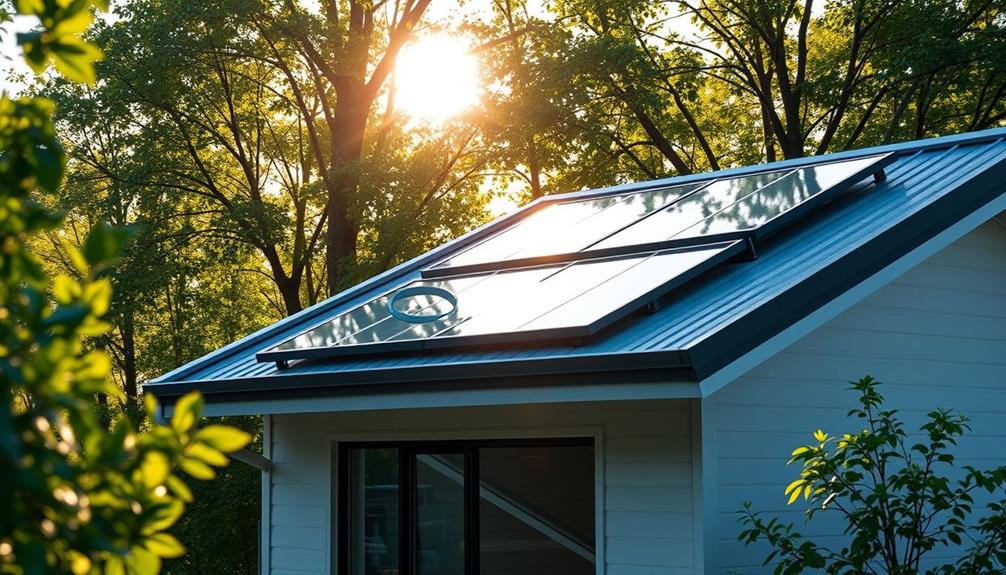
Purchasing a solar roof fan involves careful consideration of several key factors to confirm you choose the right model for your needs. Here are some essential aspects to think about:
- Attic Size: The size of your attic is vital for determining the fan capacity needed for effective ventilation and cooling.
- Sunlight Exposure: Verify your roof has adequate sunlight exposure, as this directly impacts the efficiency of the solar panel and the fan's performance.
- Local Climate: Consider the climate and humidity levels in your area, as these influence the ventilation requirements and potential for moisture buildup.
- Existing Vents: Assess the number and type of existing vents in your attic, which will affect airflow and help you select the appropriate fan model.
- Fan Type: Choose between roof-mounted or gable-mounted fans based on your attic's design to maximize ventilation effectiveness and efficiency.
Financial Incentives and Tax Credits
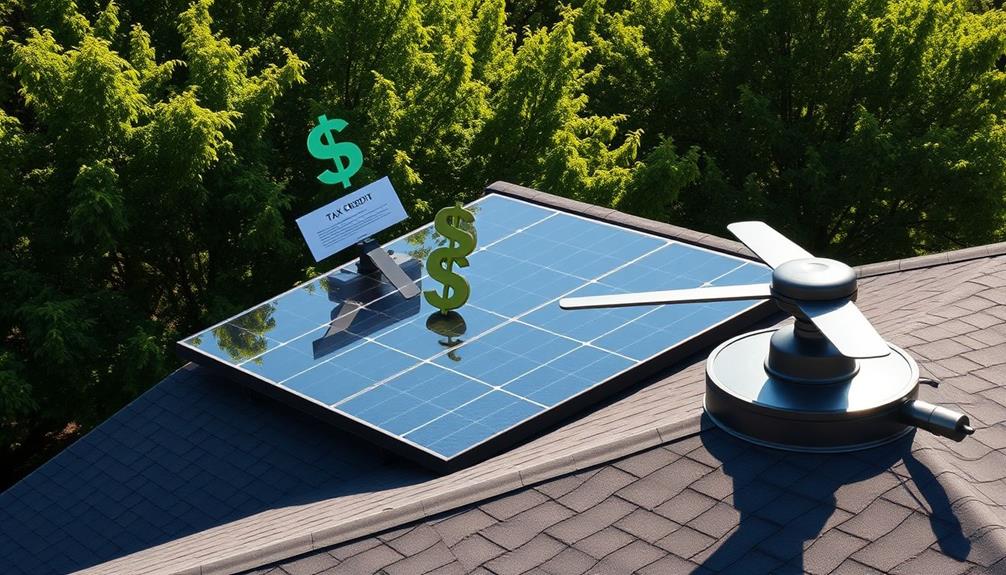
Investing in a solar roof fan can be financially rewarding, especially with the current incentives available. Homeowners in Tennessee can benefit greatly from a 30% federal tax credit on solar attic fans installed between 2022 and 2032. This makes the initial installation costs much more manageable while promoting energy savings of $60-70 monthly during the hot summer months.
Here's a quick look at some key financial incentives and their impact:
| Incentive Type | Description | Potential Savings |
|---|---|---|
| Federal Tax Credit | 30% off installation costs | Up to $1,200 |
| State Rebates | Varies by state, often significant | $300 – $1,000 |
| Energy Savings | Reduced monthly electricity bills | $60 – $70/month |
| Future Tax Credits | Decrease to 22% after 2032 | Less savings on taxes |
| Long-term Savings | Reduced reliance on electricity | $1,000+ over years |
The urgency to act is clear: the federal tax credit decreases after 2032 and expires in 2035. Take advantage of these financial incentives and start saving today!
Maintenance Tips for Solar Fans
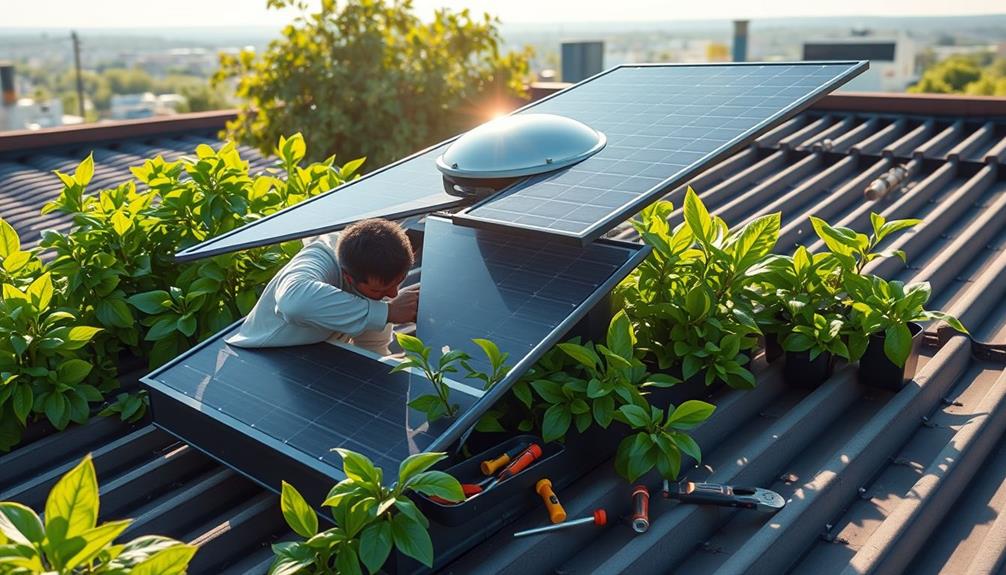
To keep your solar roof fan running efficiently, regular maintenance is essential. By following these maintenance tips, you can guarantee peak performance and energy saving benefits from your solar fans:
- Clean the solar panel: Use a damp cloth to remove dust and debris, maximizing sunlight absorption.
- Inspect the motor and blades: Periodically check for wear or blockages that could hinder airflow and performance.
- Check for obstructions: Look for overhanging branches or debris that might block sunlight or airflow to the fan.
- Perform a visual inspection: Examine the roof and surrounding areas for any leaks or damage that could affect the fan's operation and your roof's integrity.
- Monitor the thermostat: Make sure it activates during high-temperature days to maintain proper attic ventilation.
Impact on Home Energy Efficiency
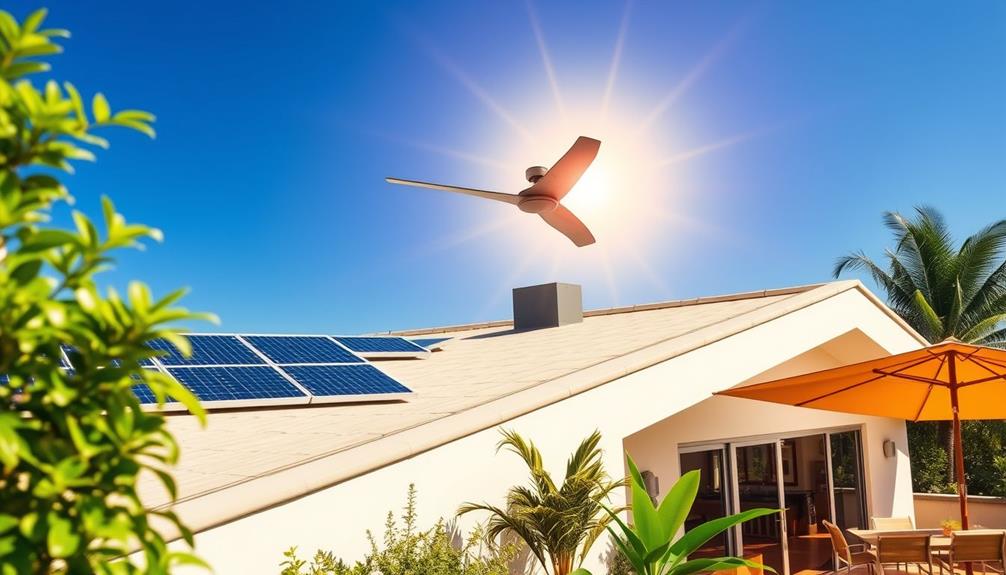
Regular maintenance of your solar roof fan not only keeps it running smoothly but also greatly enhances your home's energy efficiency. By effectively managing attic ventilation, solar fans help you save on air conditioning costs—up to 30% in some cases.
When attic fans remove heat and moisture buildup, they reduce the strain on your HVAC system, prolonging its lifespan and ensuring a more comfortable, cooler home.
During the hot summer months, the average savings from using solar attic fans can reach $60-70 per month, which directly contributes to lowering your utility bills.
Plus, with proper installation, these fans can operate maintenance-free for over 15 years, making them a smart long-term investment for energy efficiency.
If you installed your solar attic fan during 2020-2021, you may also qualify for a 26% federal tax credit, adding to your financial benefits.
By choosing solar fans, you're not just keeping your home cooler; you're also taking significant steps toward saving energy and reducing your overall environmental impact. Solar outdoor fans are powered by the sun, which means they don’t contribute to your electricity bill and rely on renewable energy. This makes them an eco-friendly alternative to traditional electric fans. Additionally, by installing solar outdoor fans, you can decrease your carbon footprint and contribute to a more sustainable future for the planet.
It's a win-win for your wallet and the planet!
Community Support for Solar Initiatives

Community support plays an essential role in the adoption of solar initiatives, making renewable energy more accessible and appealing to residents.
When communities rally behind solar projects, they create an environment that encourages energy efficiency and sustainability.
Here are some ways community support enhances solar adoption:
- Local governments and nonprofits can receive cash refunds for solar projects, boosting participation.
- Community initiatives promote energy efficiency in schools, inspiring the next generation.
- The Inflation Reduction Act's tax incentives make solar upgrades financially feasible for homeowners.
- Collaboration across various sectors fosters a unified approach to clean energy solutions.
- Awareness campaigns educate residents about the benefits of solar tax rebates and incentives.
Frequently Asked Questions
Do Solar Attic Fans Help Cool Your House?
Yes, solar attic fans help cool your house by expelling hot air from the attic. They reduce heat buildup, lower indoor temperatures, and improve air quality, ultimately enhancing your home's comfort and energy efficiency.
Do Solar Attic Fans Reduce Energy Costs?
Yes, solar attic fans greatly reduce energy costs. They lower attic temperatures, decreasing your reliance on air conditioning. By using free solar energy, you save money on electric bills while extending your roof's lifespan.
What Are the Disadvantages of Solar Attic Fans?
You might think solar attic fans are the perfect solution, but they can struggle in low sunlight areas, require significant upfront costs, and may not cool large spaces effectively. Maintenance issues could lead to costly repairs, too.
Will Solar Panels Keep My House Cooler?
Yes, solar panels can help keep your house cooler. They power solar attic fans that expel hot air, reducing indoor temperatures and easing your air conditioning's workload. You'll notice lower energy bills during summer months.
Conclusion
Incorporating a solar roof fan into your home is like giving it a refreshing change while slashing your energy bills to smithereens. Not only do these fans keep your space cool, but they also boost your home's energy efficiency and promote a greener planet. With easy installation and potential tax credits, there's never been a better time to make the switch. Embrace the power of the sun and enjoy a comfortable, eco-friendly home!
